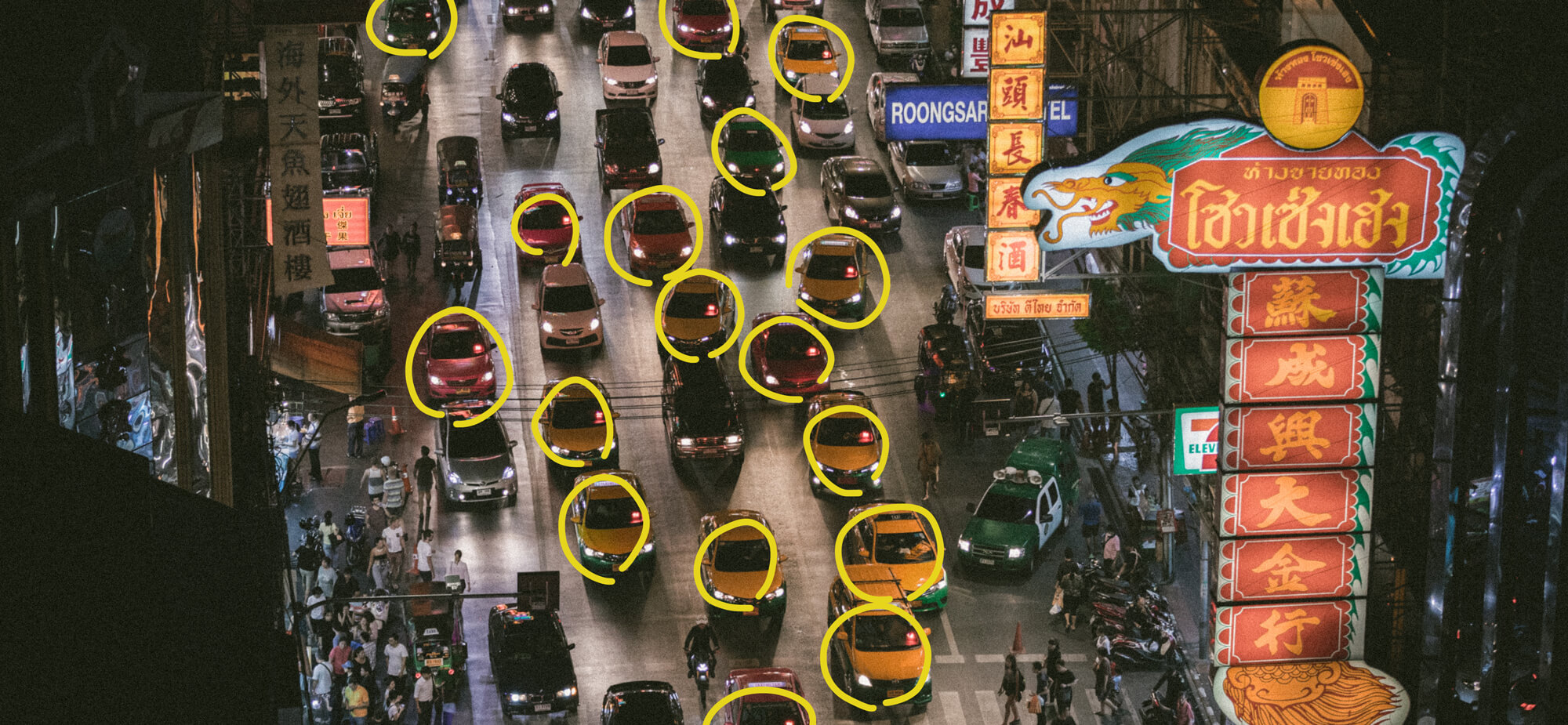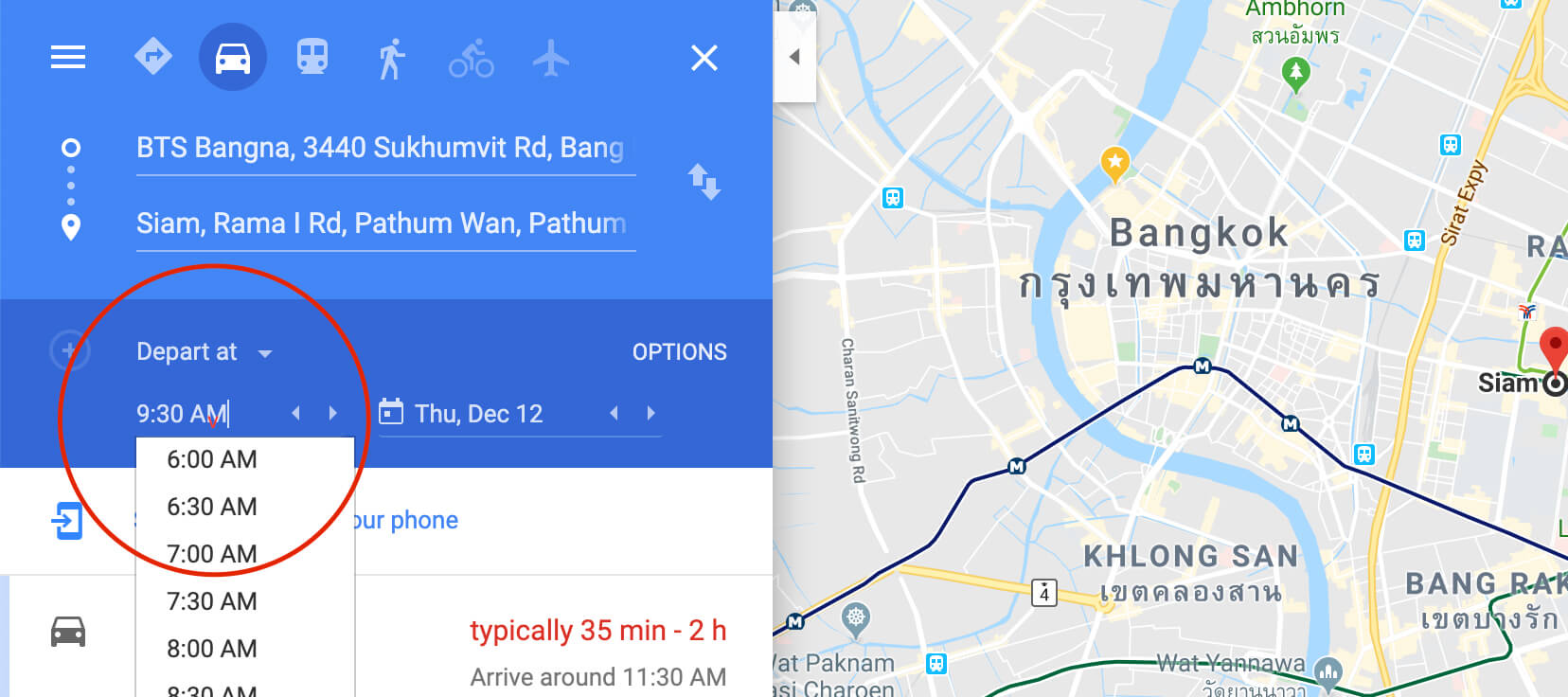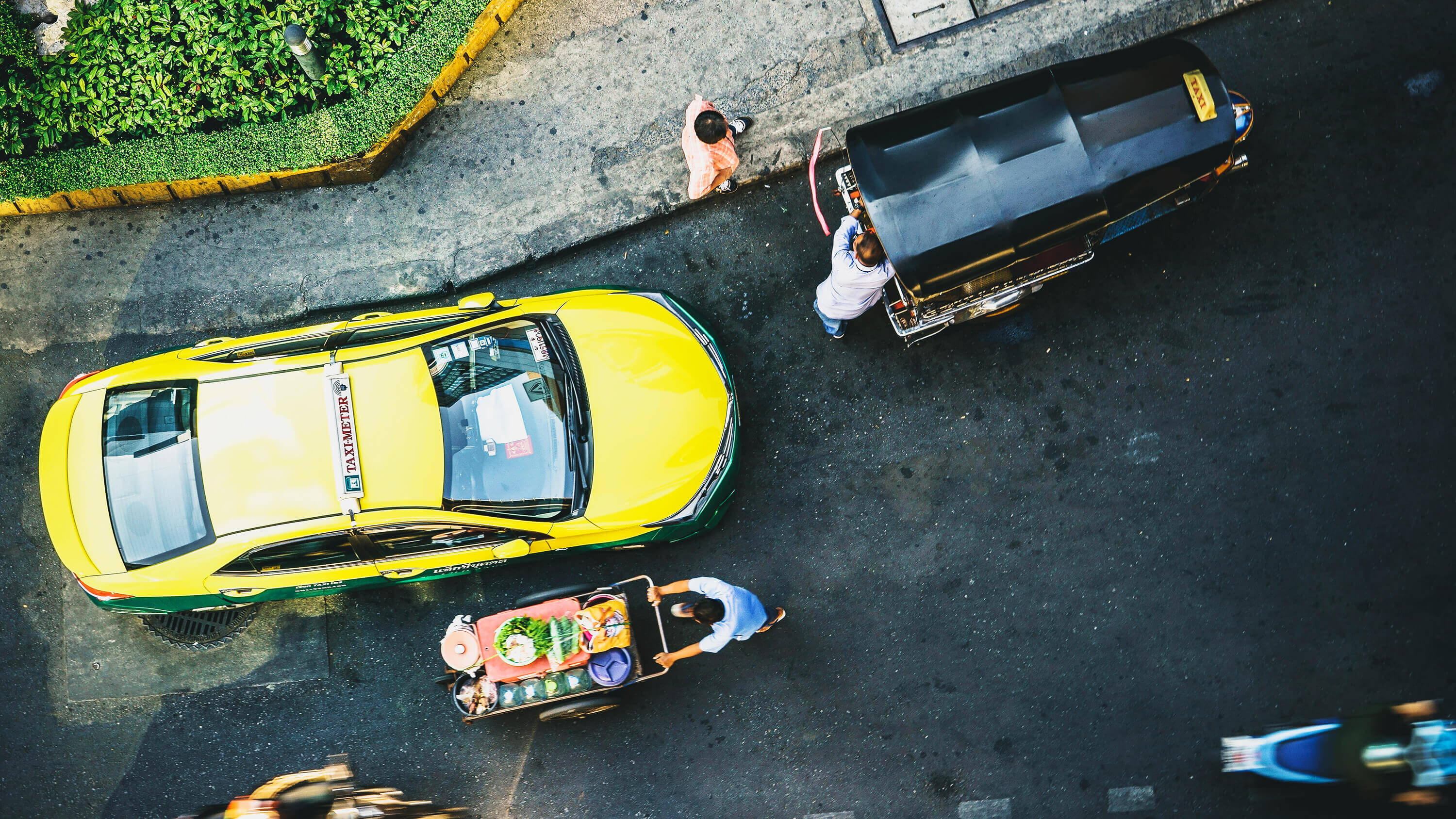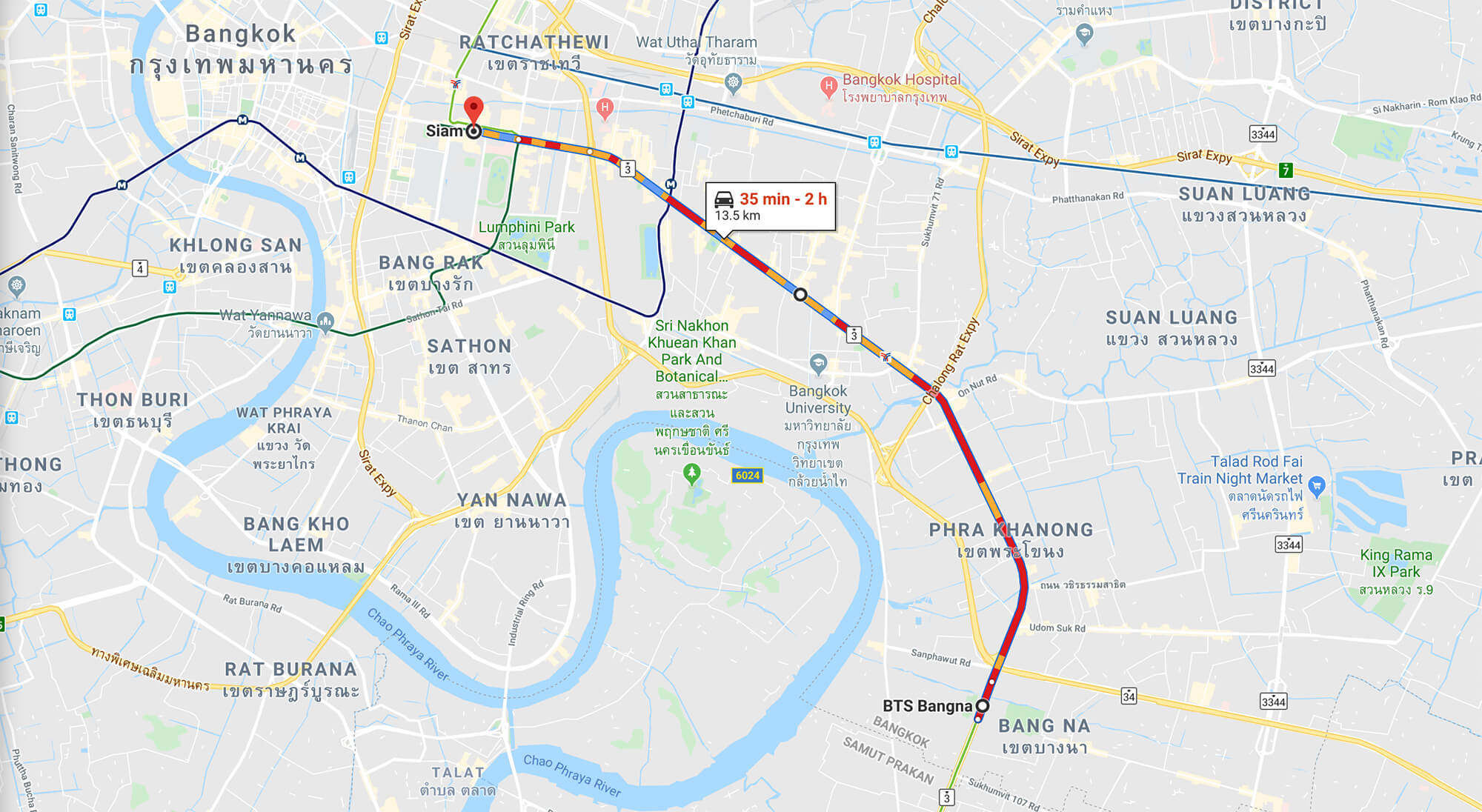How to use local taxis in Bangkok without getting ripped off or lost
Aside from being very cheap, the Bangkok taxi (แท็กซี่ – taek see) is famous for all the wrong reasons. Tampered meters, jewelry shops, having “no change”, boom boom, ping pong shows, and every other trick in the book to squeeze a few more baht from your pocket.
The truth though – most taxi drivers are genuine and they’re there to get you from A to B.
I’m going to share my 10 years of experience regularly using Bangkok taxis so you can avoid feeling lost or worried you’re going to be taken advantage of.
Knowing your destination
If you don’t speak Thai, make sure you know how to pronounce your destination in English (sometimes quite difficult as you’re going to need to sling your best Thai accent on it). As a backup, have the name of the place in Thai on your phone or paper, their phone number, even a photo if it’s a tourist attraction. Rarely will it help to show them a map on Google – they don’t seem to navigate that way and in my experience, it causes more confusion.
Many drivers in Bangkok are seasonal drivers coming from Issan and won’t know specific coffee shops or attraction names – especially in English. The best way is to navigate by area and the ‘soi’ which is just the number of the road. If you want to go to a gym near to Sukhumvit Soi 101, then you’ll just want to ask the driver for Sukhumvit Soi 101 and either walk from there or give directions.
Hailing a taxi
There’s no need to call or book – you have the biggest selection of taxis you could ever ask for. It seems that in Bangkok, every second car is a taxi – it’s amazing.
You should hail a taxi that is already driving. There are some exceptions such as local shopping malls or when there’s a police officer managing taxi hotspots, but in tourist areas such as the Grand Palace, Khao San Road, or Central World, they’re waiting for fixed fares and will rarely use the meter.

You won’t have any problems finding a taxi.
First, if possible make sure you’re on the correct side of the road for the direction you want to travel in. Then you’re going to want to look out for a regular taxi (not SUV, unless you have more than 4 people). You can spot available taxis by the bright red or green text in the lower right-hand side of their window screen as they come towards you (see image above) – it reads ว่าง in Thai, which translates to ‘free’ or ‘available’.
Taxis can be red, yellow, green, pink, blue – or a mix of several of those colors!
You’ve spotted a taxi, so at the side of the road, put your hand out, not as if you are waving at somebody up in the air, but just directed at the floor with a little flutter of your hand, as if you are showing the driver where to stop. If they saw you in time, they’ll stop for you.
Now, sometimes they roll down the front window for you to talk to them, but usually, they’re expecting you to open the back door and shout your destination to them before getting in – at which point they’ll either tell you a fixed price or nod their head and say yes. If they give you a fixed price, all you need to do is close the door and get the next one. If they say yes, hop in (to the back of the car, unless there’s more than two people riding).
You don’t need to ask them to put the meter on. That is a rookie move. It shows you don’t know how taxis work.
When you get into your taxi, the driver should press a button on his meter to turn it on (within 10 seconds), if he does not, remind him to do so. If he still does not, ask him to stop, don’t pay and get out.
Fares & tollways
Fares
Taxi meters start at 35 baht and doesn’t increase for the first 2km. After this, it increases quite slowly by 2 baht based on time and distance – more so the distance which is why drivers do not like being stuck in traffic. Taxi fares are very low in Bangkok and haven’t increased for a long time.
Most rides across the city cost between 50 and 100 baht and if you’re doing a long journey to or from either airport you should expect a maximum of around 500 baht on the meter depending on where you depart from and how much traffic there is.
Tollways
Prices on the meter do not include tollways – if you need to use a tollway, you will need to have cash to pay these – you don’t need the exact change. Prices range from ~25 to ~75 baht for each toll – sometimes requiring several to be used.
Drivers will usually use the word ‘highway’ in English and ask if you want to use it. It’s hard to know for sure if it’ll be worth it – Google Maps is usually your friend here. It’ll let you know if there are tolls on your route.
If it’s after midnight, early hours of the morning or a weekend, it’s likely you don’t need to use the tollways.
Being refused a ride
If you’re trying to catch a taxi from a touristy area or to/from a place with a lot of traffic, the driver may tell you one of two things. Either a straight no – he won’t go, or a fixed price. Either way, close the door and catch the next taxi – it’s common. Sometimes you’ll be refused 5 or more times in a row, but that’s ok – keep going. Paying their fixed fees is only encouraging them to continue ripping people off (both tourists and locals face this problem).
It is illegal for a taxi driver to refuse a passenger, and they do often get caught, but it’s not worth the time to argue when there are so many available taxis.
It’s also possible the driver has a legitimate reason and he’s saving you from being stuck in 2 hours of traffic for a 20-minute journey. Traffic really is bad in Bangkok and there are often other transport methods you could or should use to get to your destination.
Traffic
As I just mentioned, traffic in Bangkok is a real mood killer. Traffic is always bad somewhere – all day, every day. It’s especially bad during the usual rush hour times 7-10am and 4-6pm. If you’re traveling after midnight, traffic is usually much lighter and at this time, a taxi is usually your only option anyway.
You can check the traffic on Google Maps by inputting your location and the destination and pressing Directions. You’ll get a time prediction but they’re often wrong.
Pro tip: If you’re planning in advance, you can set the date and times you will be traveling – Google will then use historical data to predict how heavy the traffic will be on your route. Especially useful for catching flights.

Plan in advance with Google Maps
If there’s a lot of traffic on your route, consider taking a boat, train, or motorcycle. Locals would usually fix this issue by taking a motorcycle to the closest BTS or MRT station and then take a train. If you wanted to travel the length of Sukhumvit Road from Bang Na to Siam for example – it would rarely be better to do this in a taxi than directly taking the BTS Skytrain. Sukhumvit has some of the worst traffic in the city and the train is just faster.
Do your research on Google Maps before you set off and consider if your route is possible by BTS or MRT.
Getting out
You can tell your driver to stop almost anywhere you would like. You’ll then need to pay him, check you haven’t forgotten anything, and get out.
Be careful to look behind the car for motorcycles – they’re overtaking cars on both sides and even though you would think they’d expect someone to get out of a stopped taxi, sometimes they don’t. The damage caused will be your responsibility, so be careful.
Taxi scams
Jewelry shops, suits etc – If your driver insists on taking you to any kind of shop or restaurant that is not your original destination, say no thank you. They’re not trying to be helpful, you’ll be buying overpriced goods and giving them a cut. For this same reason, it’s not worth asking a taxi driver for suggestions as their answer will be biased.
Closed attractions – Most of the time, if a driver tells you something is closed, it’s because they want to take you somewhere else where they’ll benefit. Of course, it’s possible that it is actually closed but you should figure that out by yourself. This is a popular scam around the areas containing the Emerald Buddha and Grand Palace.
Girls and ping pong shows – Skip anything related to ping pong shows, sexy girls or boom boom – it’s sketchy, possibly dangerous and a scam. There’s not much more to say on this other than avoid it. The girls may or may not be sexy.
Tampered meters – I was taken for a ride with a tampered meter the very first time I landed in Thailand. I queued up at the official taxi stand in Suvanabhumi airport and took my taxi to Sukhumvit Soi 12. After I arrived I paid 1200 baht – only months later I realised the fare should be 3x less. If you notice a meter running faster than usual, conclude your ride as soon as possible and find another taxi.
Long routes – Less common as taxis are quite cheap. They make their money from a higher passenger turnover. However, it’s still a thing. You should check Google Maps to find the direction you need to go in and roughly how long it should take. Sometimes drivers will take a slightly different route to avoid traffic or tollways.
Free rides to nightclubs – Free rides to nightclubs are not usually a scam – this happens a lot around lower Sukhumvit. Many taxis will offer you a free ride to a specific nightclub as that nightclub will reimburse them for bringing you there. You won’t pay more for the club but if you decide not to go in, you’ll have to pay for the taxi – probably at a higher fixed price than it would usually be – in my opinion, not worth the hassle.
Airport taxis
Bangkok has two international airports. The older airport is Don Mueang (DMK) and it’s a bit north of the city. The newer one is Suvarnabhummi (BKK) is 20km east of the city. Taxis are usually only between 200 and 500 baht from either airport to most places in town, so they’re often the best way to get to your hotel. Both airports have a taxi queue on the ground level. Depending on when you arrive the queue can be very long. They also have a 50 baht surcharge. There is a uniformed attendant who helps communicate your destination to your driver, but that’s no guarantee.
I think when traveling from either airport to your hotel, using Grab (detailed below) is the easiest option – however, there’s one other trick – the departures level…
You can go up two floors to the departures level and get a taxi that has just dropped someone off. The taxi drivers here are happy to not have to wait in the queue for a passenger and will usually take you anywhere you need to go without a fuss. They’ll also almost always use the meter, unless there are a lot of other people waiting.
At DMK this is pretty reliable, but in the evening and early night hours there can be a lot more people waiting than taxis dropping people off, especially at the domestic terminal. You can easily walk between terminals on any floor.
At BKK it’s a little harder. Taxis don’t drop people right in front of the terminal. You have to cross that first road and get them at the second road. The airport tries to prevent this with a large turnstile that only turns to allow traffic from the taxis toward the airport. You can hop the barrier fairly easily, but you can also slide around the turnstile if you turn it a bit, pulling it toward yourself so that it’s an x shape instead of a + shape.
Read our arrival guide for more transport options.
Change & tipping
Tipping is not necessary but it’s common to round up to the nearest 5 or 10 baht.
I’ll warn you that if you use a taxi without having 100 baht notes or smaller, you may have trouble getting change from your driver. It’s common to claim “no have change” – and I’m not sure how you’re going to prove that they do. I’ve asked to drive on to a 7-11 before so I could get change – suddenly the driver found some coins in his center console.
Take a selection of 100 and 20 baht notes plus some coins if you want to pay the exact fare.
Etiquette
Keep your feet on the floor – I often see people putting their feet up on the center console or putting one leg up on the other which both points the bottom of your feet at the driver and brings your dirty shoes near him. It’s not nice anyway, but etiquette in Thailand is quite clear when it comes to the bottom of your feet.
Don’t drink alcohol – It’s technically against the law to drink in any kind of vehicle, including taxis and both you and the driver could get in a little trouble for it. If you must insist, at least ask the driver first.
Food and drink – You can eat and drink in taxis but try not to stink the place out with durian or fermented fish. If you make a mess, clean it up.
Keep your cool – If your taxi driver is frustrating you, it’s always avisable to keep calm, pay the fare and catch the next taxi.
Lost possessions
Forgetting your phone or even a bag inside a taxi is quite common. If it happens to you, you can try two things:
1. Call the taxi hotline – Call 1681, you will need the license plate number for them to track your driver down but even the color of the taxi will help the operator figure out which company you were driving with. The driver can also report the lost items.
2. Call the radio – Call two radio stations: 1137 (JS100) and 1644 (FM91) and tell them what you’ve lost – taxi drivers listen to these stations and may tune in if they want to return your items.
There’s plenty of success stories out there, so it is worth a try – but I wouldn’t count on getting your phone back. If you do, a tip will be expected.
Reporting a taxi driver
If your driver seems drunk, is driving recklessly, refused to use the meter or tried any of the other scams mentioned above, you can report drivers to the Land Transport Department using the number 1584. Take a photo of the number plate of the car and make a note of the time and date.
If the issue has already escalated you might want to call the Tourist Police on 1155. See our list of other Thailand emergency numbers.
Grab Taxi
Finally, GrabTaxi. Very similar to Uber, you can order a variety of transport, delivery and even food products. It’s a great and useful app at times.
I found it usually works out a little more expensive to use Grab compared to local taxis, but it does have a few benefits such as being able to pay with a credit card and if you’re in a remote place where taxis are not regularly passing, you’ll be picked up.
There are two popular options on the app:
Grab Taxi – This is going to call a regular taxi – I don’t use this as the fare is not fixed and I have not had positive experiences. If I want a normal taxi, I’ll get it from the side of the road.
Grab Car – More similar to Uber, a private driver will pick you up and you will pay the fare displayed on your app, plus any tollways you pass.
I do recommend using Grab if you’re concerned about using a regular taxi or if you’re trying to reach a specific destination that would be hard to explain to a driver. Grab is a tool that solves some shortcomings with regular taxis.


